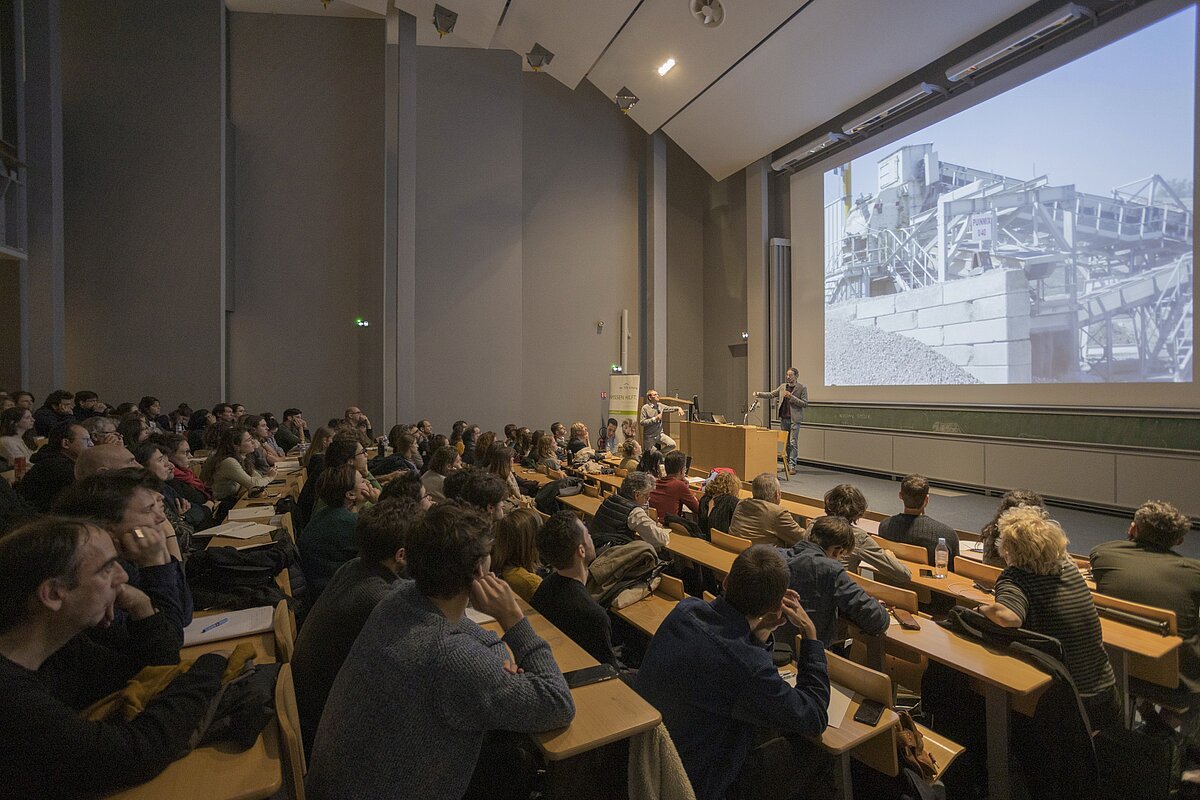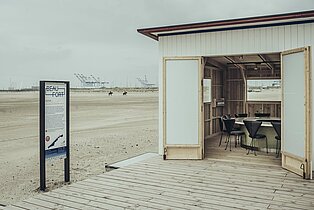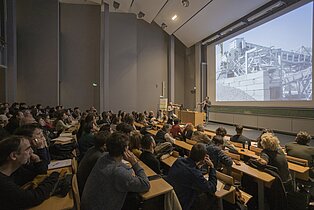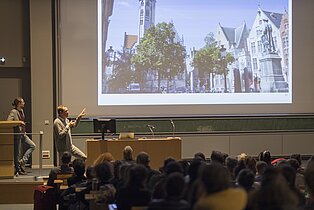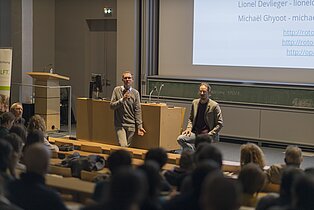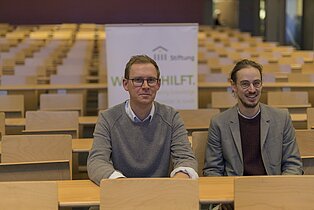Review | Michaël Ghyoot and Lionel Devlieger in Paris
Rotor, The circulation of matter
Multiple is the impression left by the Rotor collective at first glance. Is it an architectural firm? A re-employment company? A group of researchers? An artists' collective? To understand better what kind of structure Rotor is, it is easier to try to understand what connects all these practices, multiple facets of the same subject.
Rotor's topic is the circuit of matter in the construction industry. Transformed in depth in the post-war period, this sector, as sprawling as it is troubled, is now being singled out for its excessive production of waste and its greenhouse gas emissions. The collective created in 2005 now includes between 20 and 25 members with very different backgrounds: architecture, engineering, bioengineering, law, scenography, history, journalism, oceanography... What has brought together these people with such different destinies? Certainly a common ecological conscience. The collective, based in Brussels, has decided to lead a front — "quietly provocative" as they like to point out — against the over-consumption of materials. The different strategies of action put in place — research, exhibitions, publications, reuse of materials — try to influence the construction sector towards more ecological ways of working.
The reuse of building materials and components is reviving an approach that the sector had practically lost since the 1920s. The collective presents this reuse work as an age-old tradition that is now taking on another dimension. The reuse of materials is in fact motivated by the desire to combat excessive energy consumption and the waste of natural resources. The members of the collective carefully dismantle industrial products in buildings that are destined for destruction when they are declared obsolete. Deconstruction requires know-how and the development of techniques that give it a choreographed look. A dance of dismantling that would be just the opposite of that of construction. In the photos provided by the agency, we can see the members of its team at work: sitting, crouching, lying down, arms outstretched towards false ceilings or on their knees praying that the tiles they extract from the floor will not break. After selecting and removing materials and components — flooring, walls, windows, lights, etc. — Rotor restores them in his workshop so that they can be reused in another site. The images give the impression of a big move. XXL boxes are filled with pieces of buildings meticulously arranged, stacked, numbered — the past is not reduced to dust, but moves to another future.
A website called Opalis — anagram of spolia (1) — was launched in 2016, to create a link between sellers and their potential buyers. It is a kind of Amazon of reuse which includes both materials recovered by Rotor and those from other companies, often long established in the market. This real library of fragments of buildings has enough to feed fantasies. Intended to grow over time, it can only become disproportionate. Let's imagine in the future, a material library with millions of items for re-use. Straight out of a short story by Borges, this Babel library of architectural elements, would allow the recombination of materials from different geographical origins, different periods of history, conceived under logics lost during the move, a dilution of styles in a unique mixture.
More seriously, Rotor offers a design assistance service to accompany the integration of these reused materials in new buildings. It helps other architects to think about this integration upstream, from the sketching phase. The materials are often reassigned to a task other than the one designed for their first use. They begin a second life and a second function at the same time. A parquet floor becomes cladding, a truck floor becomes a nightclub floor, a partition becomes a table.
Over the years, through their research, Rotor members have become true detectives of the troubled circuits of matter. The investigations they have carried out are presented in the form of stories, maintained by a narrative framework, and are communicated in the form of exhibitions or publications. In 2010, they presented a study on the wear and tear of materials at the Venice Biennale. They analyse the factors of ageing and its consequences on our perception ("Usus/usures. Etat des lieux - How things stand"). In 2012, starting with the example of Gyproc, the Belgian plasterboard production subsidiary of Saint-Gobain, they track the mechanisms for awarding the C2C ecological certificate, showing how little coherence there is between the ambitions of its creators and reality ("Le cerisier et la plaque de plâtre", Criticat n° 9). On the occasion of the Bruges Triennial, they studied the proliferation of Chinese crabs, which arrived on Belgian shores a hundred years ago. This study, external on the subject of the economy of matter, gave rise to an exhibition tracing the arrival, proliferation and impact of these invertebrates on existing ecosystems, embodying globalisation ("What's/Who's Eating the Chinese Mitten Crab", 2018). For Manifesta 12 in Palermo, a travelling European artistic event, they retrace the history of the Pizzo Sella hill, colonised by an urban development project that has become one of the most striking symbols of real estate corruption in the region. One of these concrete structures, visible from the valley, is then transformed into an observatory to create panoramas - a reversal of perspective.
All these researches are based on specific examples, analysed in details. Starting from the particular, Rotor reveals general drifts in the construction industry.
This double interrogation of the industrial context and the possibilities of reuse have led to a third reflection, the one of our look on materials. Objects, furniture, materials, buildings, why we throw them away or why we keep them, Rotor raises the question of our criteria of appreciation. Our repulsion of the wear and tear of modern materials promised to eternal freshness. Our attraction towards the patina of old stones and wood. The fanatical conservation of all stone walls. The rejection of the Brussels postmodernism of the 70s and 80s. The judgement of taste has a direct influence on the market value that can be attributed to these second-hand materials. Materials are not judged solely on the criteria of dismantling and transport. They are subject - like any product - to aesthetic and even emotional judgement. An example given by Rotor is Formica, a robust material, easy to dismantle, transport and clean, but a victim of rapidly changing tastes. As its appearance can be summed up by the choice of its surface print, its obsolescence factor is mainly linked to the passage from one fashion to another, from one range of colors or patterns to another.
Without ecological idealism, Rotor develops a pragmatic approach which rubs up against the complexity of reality. They seek to influence habits and even change legislation concerning reuse in the construction sector. To widen the possibilities of reuse, the collective and other specialists suggest integrating upstream, from the design phase, a reflection on the deconstruction of the building to allow the recovery of as many components as possible. It is paradoxically in commercial architecture that such constructive thinking seems to have already been developed. In his essay Junkspace, Rem Koolhaas describes these spaces intended to be "consumed" quickly, as an architectural version of junk food: "Where as detailing once suggested the coming together, possibly forever, of disparate materials, it is now a transient coupling, waiting to be undone, unscrewed, a temporary embrace with a high probability of separation (2)". Could not this architecture of the disposable whole become that of the reusable whole?
Côme Rolin
(1) Spolia is the Latin term given to the practice of reuse in ancient times, motivated by economic reasons or the desire to appropriate the cultural property of a defeated enemy.
(2) Rem Koolhaas, Junkspace, October, Vol. 100, Obsolescence. (Spring, 2002), p. 178
Interview-Video
Michaël Ghyoot and Lionel Devlieger spoke about their lecture at the November Talks in Paris.


